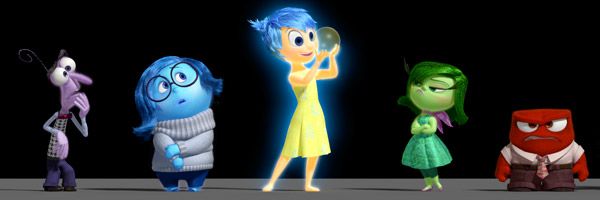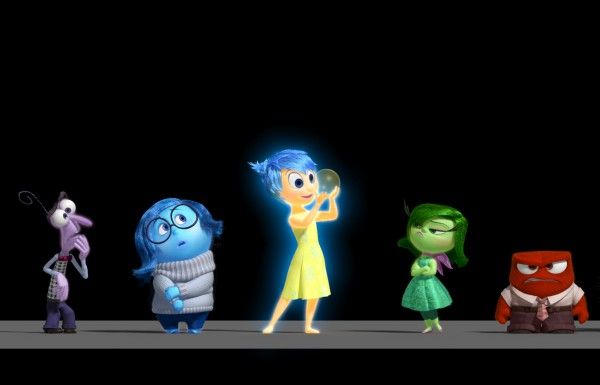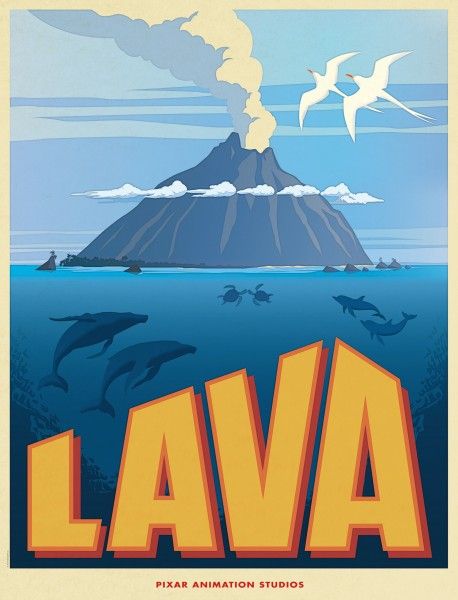It’s simply astonishing how effortlessly Pete Docter is able to condense massive amounts of plot & exposition into the most accessible and comprehensive manner possible. Take a gander at the opening of Docter’s previous film Up, distilling an entire life span and romantic relationship into just ten minutes. The filmmaker’s latest Pixar venture Inside Out – set for release a year from today – (on paper) could seem almost unbearably convoluted, but in Docter’s deft hands it all becomes so very easy to follow. Set inside an adolescent girl’s mind, Inside Out focuses on the ‘emotions’ – Anger, Joy, Sadness, Fear & Disgust – that control the personality and actions of their host’s body. Think of the film sort of as the Disney version of Being John Malkovich. The genius of Docter is to mix the art-house cerebral ideas of that film (e.g. the existential quandaries of identity) with more traditional Disney sentimentality (the importance of the familial unit is front and center here).
At a special Pixar event tonight, Docter and his producing partner Jonas Rivera gave an exclusive presentation of Inside Out, including a preview of the opening five minutes of the picture. In addition, the Pixar short film Lava (which will play before Inside Out) screened to the attentive audience. For highlights from the presentation, Inside Out and Lava, hit the jump.
Highlights from the Inside Out Presentation:
Docter opened the Inside Out presentation by stressing how important it is to “do something new to push the limits of animation.” However he was quick to point out that often times radical ideas are rejected by modern audiences, craving the ‘same old, same old.’ These two conflicting mantras led Docter to the belief that “while you can do something new and different, you also have to take the audience somewhere they can relate to.”
Inside Out is based on Docter’s own relationship with his daughter. Watching her grow up, Docter saw how quickly she changed from a joyous child to a sullen teen. “What happened to her?” Docter questioned, “Where did her childhood joy go?” It was this experience that gave Docter the idea to set a film within the human mind – allowing him to explore new and thoughtful ideas in a setting everyone can relate to (i.e. themselves).
Docter showcased each of the main characters that make up the inner workings of the girl’s mind: Joy, Anger, Fear, Disgust & Sadness. “We wanted the emotions to look like what they feel to us” Rivera added, “We thought of them as our Seven Dwarves.” Each of the emotions are anthropomorphized in typical Disney fashion, with round expressive eyes and upright bodies. ‘Anger’ (as voiced by comedian Lewis Black) is a short red-colored man dressed in business suit attire; ‘Fear’ (as voiced by Bill Hader) is a bug-eyed purple thin-stick of a man; ‘Disgust’ (voiced with amusing nonchalance by Mindy Kaling) is a green skinned woman with a green dress and a pink neck scarf; ‘Joy’ (Amy Poehler) – the ostensible lead of the picture has long blue hair and the largest eyes you ever did see; and finally Sadness (Phyllis Smith) is the Eeyore of the group, slumping around silently, eyes fixated to the ground.
Each of these emotions/characters help their host (Riley) deal with the various travails of life. In the opening sequence of the movie, we watch the newborn Riley come into this world – and then we zoom in closer to her head and then inside her head. There – ‘Joy’ is born, the first of the emotions, just as Riley sees her parents holding her above. Thirty seconds later – as the baby begins to cry, ‘Sadness’ emerges next to Joy.
The emotions guide Riley’s actions and responses in a headquarters located in the back of the girl’s mind. Using a control panel (much like what you would see in a Star Trek episode), each of the emotions takes charge depending on the circumstance. When Riley is about to eat broccoli, ‘Disgust’ takes the helm to nip that in the bud. If Riley is about to have a tantrum, ‘Anger’ takes the lead. If Riley is about to do something that may get her injured or worse, Fear captains the ship.
The emotions observe everything Riley sees and experiences on a blue monitor – a consciousness screen. From there, each of Riley’s experiences are turned into an spherical memory ball. “They’re like colorful little snow globes and they loop memories back and forth.” Docter said, “Everything that has happened is stored in these globes.” When Riley wishes to recall a memory, the orb containing that memory projects it onto the consciousness screen, much like a film projection.
The conflict in the film stems from Joy and Sadness. As Riley grows older, Sadness begins to exert control more often. This prompts a disagreement with Joy, ending with both of the emotions flung from the headquarters into the wilderness of the mind. From there, the duo must work together to find their way back to headquarters before Fear, Disgust, & Anger (who are now the only emotions left in charge) mess things up royally for Riley.
“Historically at Pixar we’ve attempted to root our stories in the physical real world – but here we’re pushing things to the extreme for a wonderful cartoony style.” Docter summarized, “Though we were inspired by anatomy, we purposely steered the art department away from [any literal depictions of the mind]. The story really talks more about abstract stuff like consciousness, memories and personality attributes. Things that make up who we are.”
Finally after the Inside Out presentation, first time filmmaker (and long time Art Department head) Jim Murphy took the stage to preview his Pixar short Lava. It’s a cute, if slight, tale about a lonely Volcano, prone to lament – via song – how he yearns for another to ‘lava’. Unbeknownst to him, a female volcano lurks below sea level, listening to his ballad. The animation is often stunning and the music catchy – but there’s something curiously missing here – perhaps an extra beat or two. As it stands, Lava is a pleasant enough diversion, but doesn’t quite reach the heights of classic Pixar shorts The Blue Umbrella or Geri’s Game.
Inside Out & Lava hit theaters everywhere June 19th, 2015.



